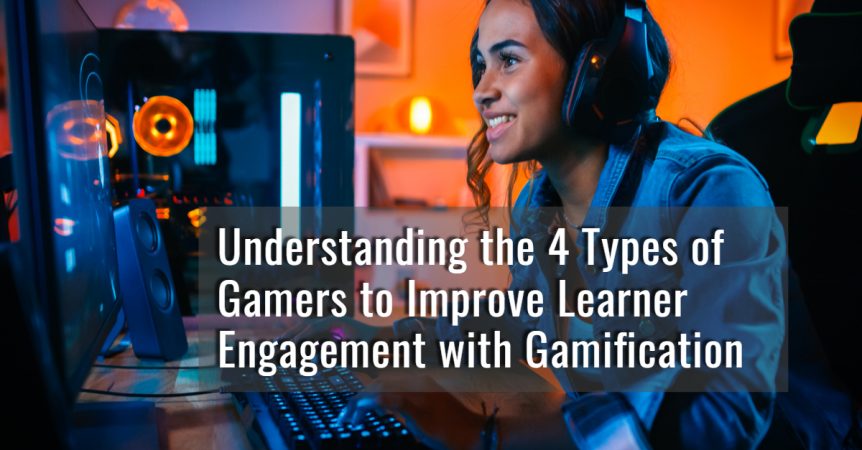Understanding the 4 Types of Gamers to Improve Learner Engagement with Gamification
Gamification is often seen as a must-have element in high-quality e-learning courses. There are good reasons for this. Gamification elements increase learner engagement, and they enhance satisfaction rates. When used correctly, they can also be excellent teaching tools, facilitating the learning process and helping learners grasp the topic.
That said, adding a gamification element to your e-learning course is not a guarantee of success. You have to use gamification strategically, and you have to do it right. Gamification is not something that you can cut corners with.
You need to invest in the development of gamification elements to ensure they resonate with learners. It is also important to ensure the game mechanics are authentic. After all, the people completing your e-learning course are likely to be familiar with at least some form of gaming, including playing games on their smartphones.
One crucial part of optimising the gamification elements of your e-learning course is to ensure the gameplay is as appealing to learners as possible. This starts with proper planning, including understanding the types of gamers you are dealing with.
That phrase might sound strange if you are not involved in gaming, but there are different types of gamers that have been categorised by researchers. Those categories can be helpful when developing the gamification elements in your e-learning courses. By understanding the preferences and motivations of your learners, you can tailor the mechanics of the course to make it appealing to them.
Types of Gamers and How those Types Relate to E-Learning
The main research to categorise types of gamers was conducted by Richard Bartle. He studied people playing massively multiplayer online games. From this research, he identified four main types of players.
- Socialisers
- Explorers
- Achievers
- Killers
Before going into each different category, it’s important to mention that people will fall into more than one category, and most have a bit of every type to a lesser or greater degree. In other words, understanding the different types of gamers doesn’t mean tailoring your e-learning course to one single category. Instead, knowing the categories and the personalities of the people who will be completing your course will help you understand the best way to motivate and engage.
Socialisers
The motivation for playing games with socialisers is the social interaction that is involved. They are still interested in the game, and they want to win and do well. However, socialising is a big part of the experience. This sets them apart from some of the other categories where it is common to play alone.
Socialisers will, for example, seek help from others when they get stuck, offer help when they are able to do so, and provide encouragement and support to others involved in the game. These characteristics present a range of opportunities when creating gamification elements for e-learning courses.
Examples include making it easy for learners to interact with others completing the course, such as starting or participating in discussions. Setting group tasks can also be beneficial, particularly if there are group awards for success. Making an emotional connection is also important, such as through the story you tell as part of the mechanics of your gamified element.
Explorers
Explorers like to explore the world created in the game, finding new items, hidden elements, and rarely visited places. They are more focused on the process of the game rather than getting a specific result. So, playing a game isn’t necessarily about success or failure. Discovery and learning are much more important.
To appeal to this type of gamer, it is important to create an engaging narrative that the learner can become immersed in. Giving rewards for finding out new things can also be beneficial, as can giving points for completing tasks.
Explorers can also become content creators for your e-learning modules, and they can help improve courses through feedback.
Achievers
Achievers are a competitive type of gamer where the objective is to win. This means they are not generally motivated by the experience. Instead, they want to achieve something, and that achievement is usually winning. In pure gaming terms, this could be winning against other players or beating the game. Achievers also want others to know they have won.
The crucial part of developing gamification elements for this type of gamer is to make the elements challenging. As the learner overcomes the challenges, they should be rewarded by giving them, for example, badges. Making those badges public so other learners can see them will also help to motivate achievers.
Killers
Killers are similar to achievers as they play games to win. However, winning is not enough for killers. Instead, they want to win, and they want to see someone else lose in the process. They want people to know they have won too. Killers are also known to use any tactic available to them to win, both fair and unfair.
It is unlikely that you will want to develop gamification elements to appeal directly to killers. However, it is important to remember the point made above that people fall into multiple categories. According to the research, Killer characteristics account for a small percentage of the average gamer’s makeup. In fact, the average gamer is mostly a Socialiser, part Achiever and Explorer, and only a small part Killer.
Therefore, you can appeal to that small amount of Killer instinct that exists in most gamers by including things like leaderboards in the gamified elements of your e-learning courses.
Optimising E-Learning Gamification Elements
The main point of gamer types in relation to e-learning is about understanding the people who will be completing your course, what makes them tick, and what motivates them to learn. Nobody will fall into one category alone, plus you will have different types of learners. The objective is to tailor the gameplay and mechanics to appeal to your audience as much as possible.
